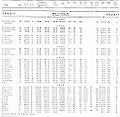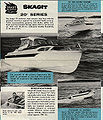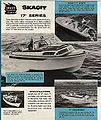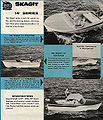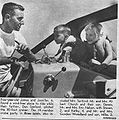Skagit Plastics
A Brief History of
SKAGIT BOATS
In the early 1950’s, when it appeared there might be a future in fiberglass boats, the owners of LaConner’s Dunlap Towing Company thought they’d get into the glass-boat business. One of the tugboat operator’s first moves was to study their neighbor to the north, Bellingham Shipyards, which had started producing Bell Boy fiberglass boats in 1952.
Sometime in 1954, Dunlap approached Art Nordvedt, who had started Bell Boy production as a division of Bellingham Shipyards. Prior to 1952, the shipyard had been quite successful building larger vessels, ranging from minesweepers to commercial fishboats, tugs and yachts. They knew how to build a good boat, and with Nordvedt’s help they learned how to design and manufacture smaller fiberglass fishing boats, runabouts and cruisers. (Amazingly, after only three years of operation, Bell Boy had built 5,000 boats in three plants around the country—the largest operation being their Bellingham headquarters.)
Dunlap wondered if Nordvedt might want to help launch a competing company, Skagit Plastics, to be based in LaConner. Since Nordvedt was happy working on the Bell Boy enterprise, he declined. Shortly thereafter, the towboaters approached one of Bell Boy’s most talented employees, Howard Roberts, suggesting he could head up the new company in LaConner—an offer he quickly accepted.
As chief designer and production manager, Roberts was able to start Skagit Boat production within a year. In its July, 1955 issue, SEA magazine published a story on Skagit Plastics, featuring the new 20-foot express cruiser designed by Roberts, which was available in either inboard or outboard models.
In addition to the now-famous 20-foot express model, Skagit offered other designs starting with an 8-foot dinghy and including small fishing boats, runabouts, hardtop sedans…and a few years later the largest fiberglass cruiser ever built—the dramatic 31-foot Saratogan.
The Skagit 20 became the company’s best-known model, with perhaps 500 hulls produced between 1955 and 1960. There were three 20’s—the Offshore (bigger cockpit), Express (more cabin) and Tyee (convertible with hardtop option), offered primarily as outboard models.
A summary of models produced over the years:
According to Jack Henriot, former Chief Engineer for Skagit Plastics, the company may have built a total of only about 1,000 boats. By his recollection, they finished about twenty Skagit 20-footers in the first year, 1955. In 1956 they built twenty-five to thirty 20-footers, including a few Tyees. In 1957 they constructed more 20’s and added 12-, 14- and 17-footers—and built the first 31-footer. In 1958 they increased production and built the full line of boats, and by 1959 they were offering all models in two plants with a total of 110 employees. (1959 and 1960 were Skagit’s biggest years in terms of production.)
Here’s an approximate production breakdown for the years Skagit produced boats:
In 1958 Skagit licensed production rights to some of their designs to two other companies— Thermolite in British Columbia (which had previously made Styrofoam coolers), and a boatbuilder in New Jersey that produced a variety of Skagit designs under the name of Guy Lombardo Boats, owned by the famous bandleader and raceboat driver. (See accompanying photos from the Guy Lombardo Boats’ 1960 catalog.) Thermolite, recognizing that a line of boats with "lite" in the name might not be well received, branded the boats "Thermocraft". Production of Thermocraft boats continued until at least 1963.
The company folded abruptly in early 1961. Jack Henriot was in charge of liquidating the assets, and at that point Howard Roberts took over one of the two Skagit plants to build a few Skagits to fill remaining 1960 orders. (Plant #1 burned in about 1965, and Plant #2, the R.V. Moore Building, remains in LaConner.)
Howard Roberts is credited with design of the Skagit 14, 17, 20 and 31-footers. Lloyd Lindberry, who still roller-skates at age 90, designed the 12-foot Fisherman and the 16-footers, and did work on other models. The Seattle naval-architecture firm of Spaulding designed the 24 and 25-footers.
Additions and corrections to this brief history are invited, since there is obviously much to be learned about details of the company’s history. – Marty Loken, FiberGlassics Northwest
Model Information:
1955 Information:
1956 Information:
1957 Information:
1958 Information:
1959 Information:
A story:
ORIGINAL FACTORY PHOTOS:
External Links:

